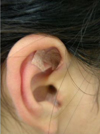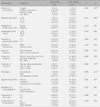Abstract
Purpose
The purpose of this study was to identify the effect of auricular acupressure therapy on dysmenorrhea of puberty girls.
Methods
This study was a pretest-posttest design with a nonequivalent control group. The subjects of this study were 61 girls who were middle and high school students in Seoul and the experiencing dysmenorrhea; 31 for the experimental group and 30 for the control group. The obtained data were analyzed by SPSS/WIN 12.0 program.
Results
The experimental group which applied the auricular acupressure therapy scored lower for low abdominal pain (F=136.13, p=.000), low back pain (F=62.79, p=.000). autonomic nervous system reactions (F=102.31, p=.000) and negative emotions on the menstruation (F=102.31, p=.000) compared to the control group. There were significant interaction effects of auricular acupressure on low abdominal pain, low back pain, autonomic nervous system reactions, and negative emotions on the menstruation between time and group.
Figures and Tables
References
1. Byun J.Y., Ahn S.G. A clinical research of the auricular acupuncture therapy on headache. Journal of Korean Acupuncture & Moxibustion Society. 1995. 12(1):355–363.
2. Campbell M.A., McGrath P.J. Use of medication by adolescents for the management of menstrual discomfort. Archives of Pediatric Adolescent Medicine. 1997. 151(9):905–913.
3. Han S.H., Heo M.H. A study on the menstrual pain and dysmenorrhea, factors influenced to them, and self-management method for them of college students. Journal of Korean Academic Society of Nursing Education. 1999. 5(2):359–375.
4. Hong K.J., Moon Y.I., Baek S.N., Ahn C.S., Lee K.J., Lim H.K., et al. Nursing Care of Children II. 2003. Seoul: Soomoonsa.
5. Jang S.B., Jeon E.M. Effects of SP-6 acupressure on dysmenorrhea, cortisol, epinephrine and norepinephrine in the college students. Journal of Korean Academy of Nursing. 2003. 33(7):1038–1046.
6. Jeon E.M. A study on menstrual symptoms, coping and relief of symptoms in female college students. Korean Journal of Women Health Nursing. 2003. 9(2):161–169.
7. Jeong H.M., Kim I.S. Factors affecting dysmenorrhea among adolescents. Korean Journal of Child Health Nursing. 2004. 10(2):196–204.
8. Jung M.K. Investigate the menstrual knowledge, attitudes, symptoms, and coping of the high school aged girls. 1999. Seoul: Ewha Womans University;Unpublished master's thesis.
9. Kang I.S. Thermotherapy's effect to high school girls' dysmenorrhea. 2001. Seoul: Kyung Hee University;Unpublished doctoral dissertation.
10. Kim G.S., Lee S.W., Choi M.A., Lee M.S. The effect on menstrual pain of relaxation therapy using biofeedback. Seoul Journal of Nursing. 1999. 13(1):7–22.
11. Kim M.Y. Degree of dysmenorrhea and self-management of dysmenorrhea in the high school girl student. 2000. Daegu: Kyungpook National University;Unpublished master's thesis.
12. Kim S.O., Cho S.H. The effect of hand acupuncture therapy and moxibustion heat therapy on dysmenorrhea women. Korean Journal of Women Health Nursing. 2001. 7(4):610–621.
13. Kim Y.H., Lee I.S. A study on the dysmenorrhea in college female students. Korean Journal of Women Health Nursing. 2002. 8(1):85–95.
14. Korean Society of Obstetrics and Gynecology. Gynecology. 1997. Seoul: Calvin Publishing.
15. Kwon J.I. The standard korean dictionary. 2004. Seoul: The National Institute of The Korean Language.
16. Lee B.K. The newest auricular acupuncture a diagrammatic chart recipes. 2002. Seoul: Chimkorea.
17. Lee I.S. Effect of moxibustion heat therapy on menstrual cramps, dysmenorrhea, and activities of daily living. Journal of Korea Community Health Nursing Academic Society. 2004. 18(1):39–49.
18. Lee I.S., Kwon H.Y. Research on menstruation state of high school girls with questionnaires. Journal of Dong-Eui Oriental Medicine. 2001. 4:149–160.
19. Lee K.J. Story of auricular acupuncture. 2004. Seoul: Gimm-Young Publishers.
20. Lee Y.J. The effect of the magnetic application for primary dysmenorrhea. 1993. Seoul: Seoul National University;Unpublished master's thesis.
21. Lim K.T., Kim T.J., Lee K.H., Hwang J.H., Oh K.S., Jun J.Y., et al. A study on patterns of menarches and menstrual disorders in urban middle school girls. Korean Journal of Obstetrics and Gynecology. 1994. 37(4):663–672.
22. Moon H.J., Kim K.B., Sok S.H., Hong K.H. A literature review about application of an auricular acupuncture therapy for independent oriental medical nursing intervention development. Journal of East-West Nursing Research. 1999. 4(1):66–76.
23. Na S.J. The effect of relaxation therapy on the reduction of premenstrual syndrome among high school girls. 1992. Gwangju: Chonnam University;Unpublished master's thesis.
24. Oleson T. Auricular acupuncture therapy - Auricular acupuncture organization between China and West. 1999. Seoul: Tae Sung Medical Publishers.
25. Sok S.H. The effect of auricular acupuncture pressure therapy on insomnia of elderly people. 2001. Seoul: Kyung Hee University;Unpublished doctoral dissertation.
26. Vicdan K., Kukner S., Dabakoglu T., Keles G., Gokmen O. Demographic and epidemiology features of female adolescents in Turkey. The Journal of Adolescent Health: Official Publication of the Society for Adolescent Medicine. 1996. 18(1):54–58.
27. Youngkin E.Q., Davis M.S. Women's health: A primary care clinical guide. 1994. Appleton: Appleton & Lange Publishers.




 PDF
PDF ePub
ePub Citation
Citation Print
Print







 XML Download
XML Download